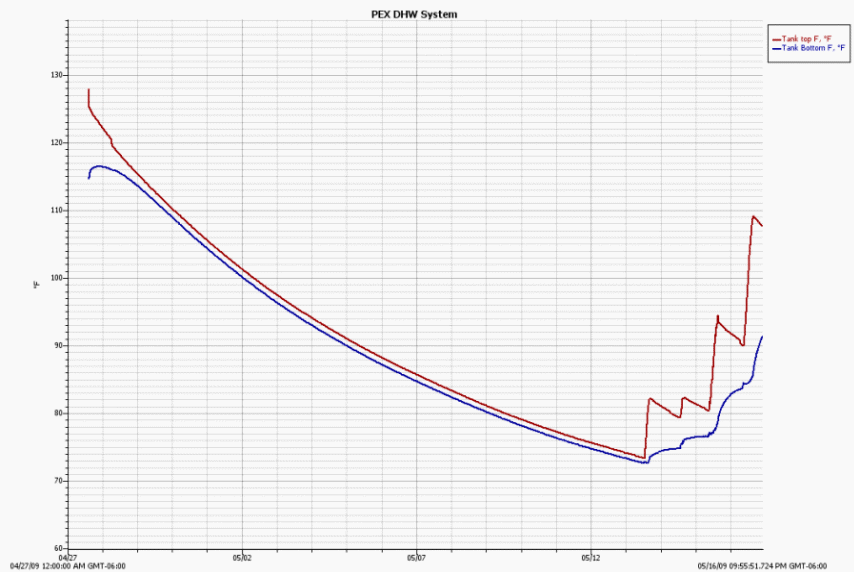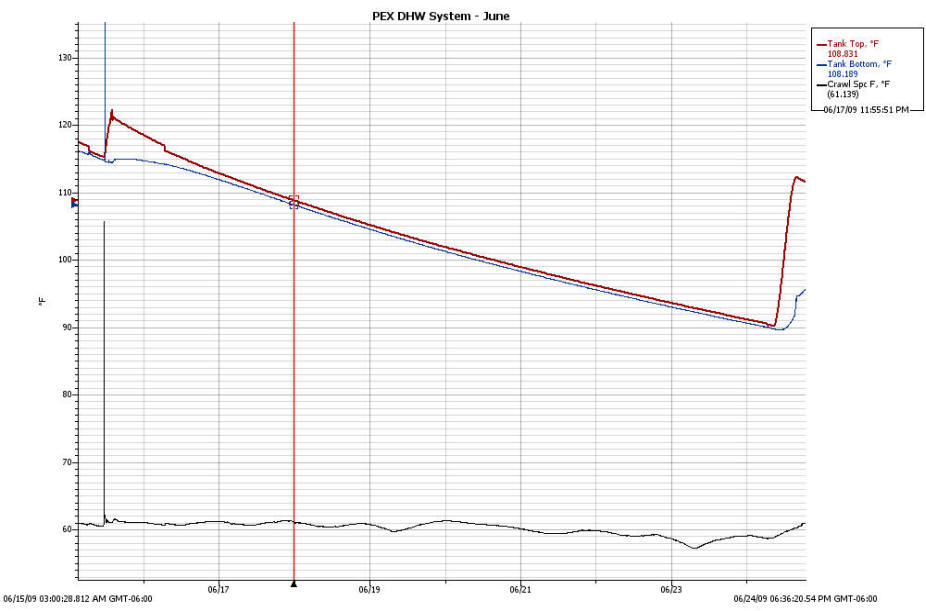
Search
The Renewable Energy site for Do-It-Yourselfers
Tank Heat Loss
Test
This is a test to estimate heat loss
from the storage tank on our solar water heating system.
The heat loss from the tank is important in that heat lost out the tank walls is
heat that can't be used for hot showers etc. As the test shows, the loss
is significant, and reducing tank heat loss is definitely worthwhile.
Page Directory:
The Test and
Actual Heat Loss
Calculated
Heat Loss
Plan of
Action
Conclusion and Recommendations
2nd Heat Loss
Test...
Pictures of the tank construction here...
The Test and
Actual Heat Loss
To get an idea what the loss from the
tank alone is, during a two week period when we were away from home, I turned
the system off, and let the tank cool down through its own heat loss alone.
The plot below shows the result. The tank went from about 120F down to
about 72F over the 2 week period.

Red line is top of tank temperature
(F)
Blue is bottom of tank temperature
(F)
Not shown is crawl space temp, which
averaged 53 F without a lot of variation.
I used the temperature drop over 2 of
the 24 hour periods to estimate the actual heat loss to be about 4.3 BTU/hr for
each degree of temperature difference between the tank water and the ambient
temperature around the tank. This actual loss is just based on how much
the tank temp drops in the 24 hour period, since there are 164 gallons, or 1370
lbs of water, each 1F drop in tank temperature is a loss of 1370 BTU.
So, when the tank is up around 120F,
and the crawl space is around 50F, the heat loss per hour is about (120F -
50F)(4.3 BTU/hr-F) = 300 BTU/hr, or 7200 BTU per day. This 7200 BTU loss
over a day is just as though you used an extra 14 gallons a day in showers etc.
Since our total hot water usage for a full day is probably less than 30 gallons,
this heat loss from the tank is significant.
So, this brings up some questions:
- Is the heat loss about what you
would expect from the R value of the insulation around the tank?
- If not, then what is causing
the excess heat loss?
- What can be done to further
reduce the heat loss, and would it be cost effective?
Calculated
Heat Loss Based on Insulation
The tank is insulated as follows:
All insulation is polyisocyanurate
with an R value of about 6.5 per inch of thickness.
Walls - 2 inches inside the
plywood tank wall + 1.5 inches outside the plywood where the frame allows
it.
The inside 2 inches is R13 and
the effective R value for the 1.5 inches allowing for bridging from the tank
frame is about R9.1, so the total R value for the walls is R 22.
Bottom - 2 inches inside the
plywood + 2 inches between the dirt and the plywood. This gives a
total R value of about (2 + 2)(6.5/in) = R 26. The dirt has 2 layers
of poly sheeting to keep moisture out of the insulation.
Top - most of the lid is 2 inches
+ 1.5 inches of insulation with a thin sheet of plywood between. The
total R value is about (2+1.5)(6.5/in) = R23
There is a fixed portion of the
lid that has only 2 inches of insulation.
I used an eyeball average of R23
for the full tank.
Heat Loss = (Area)(Tin - Tout)/(Rvalue)
For the area, I used the average
of the inside and outside surface area. = 67.3 sqft.
So, the heat loss per degree
should be
Heat Loss/ degree = (67.3 sqft)(1F)/R23
= 2.92 BTU per degree of temperature difference.
So, the actual heat loss rate is
(4.3/2.9) = 1.5 times the calculated rate accounting for only heat loss
through the insulation. There are other sources of heat loss, such as:
Any water vapor that manages
to escape through imperfect lid sealing takes about 1000 BTU per lb of
water with it.
The places where pipes enter
and leave the tank result in heat losses along the the pipes.
The insulation slab under the
tank has some gaps that air could flow through that would reduce the
effectiveness of the under tank insulation.
The thermal bridging of the
external tank frame and the edge board may result in more loss than is
accounted for above.
I use the simple 2d heat loss
equations, when it fact, this is a 3d heat loss problem, and this may
account for some of the excess of the actual heat loss over the
calculated heat loss.
Plan of Action
Presumably, these "other" sources of
heat loss account for the 50% greater heat loss than the simple R value based
calculation. Maybe its worth mentioning that every time I've ever tried to
compare actual heat loss to calculated heat in real world situations, the actual
loss has been significantly greater -- something to think about when you are
choosing insulation thickness. My guess is that that insulation
manufactures carefully pick the circumstances under which they measure the the R
values they publish. This, coupled with real world thermal bridging
and other losses probably makes it worthwhile to overdesign insulations levels.
I will have a go at reducing some of
the other heat losses mentioned above, including better lid sealing, foaming in
any gaps in insulation, insulating the pipes better where they leave and enter
the tank, and anything else I can think of. Since I have never had to add
water to the tank, I don't think the water vapor leakage is the main culprit,
but I will keep careful track of the tank water level to see how much
water is evaporating. I'll redo the test after doing this.
Even assuming that working some of
the minor heat losses can get us down somewhere closer to the calculated value
of about 3 BTU/F -hr, it seems like this is still going to be a significant
portion of the incoming solar energy that is lost instead of going to hot
showers. So, maybe more insulation is in order.
Another inch of polyiso all the way
around the whole tank would in theory raise the average R value up close to R30.
This would cut the loss down to 1 / (30/23) = 77% of what it was, or a 23%
reduction. An extra layer of 2 inch polysio would bring things up to about
R36, or a 36% reduction in heat loss.
The insulation cost is about $1 per
sqft per inch of thickness, and it would take about 3 4X8 sheets to cover it
all. So, about $100 for 1 inch more and about $200 for 2 inches more.
$200 seems like a lot for a system
that costs $1000 total!
Maybe I'll look around for a cheaper
way to insulate -- any ideas?
Some
Conclusions and Recommendations
Some conclusions based on the test:
- Heat loss from the tank is
likely to be significant (equivalent to losing 14 gallons of heated water a
day on our tank)
- A good insulation scheme is
important.
- Working on all sources of heat
loss is important (water vapor loss, thermal bridging, ...)
In hindsight, I probably would have
tried to put all the insulation inside the tank (on the inside of the plywood
walls and just behind the EPDM liner) -- I think this is the best place because
1) there is no thermal bridging for inside the tank insulation, 2) the
insulation panels are easier to cut, and 3) it takes less insulation because the
insulation panels are smaller. The only caveat is to not let the tank
volume get so low that the pipe coil heat exchanger won't fit in the tank, or
that you lose too much water volume.
2nd Heat Loss
Test After Improvements
I did a few changes to try to reduce
the tank heat loss:
- Insulated the pipes near the
tank better
- Did some more sealing of small
gaps between insulation boards and the tank framing using "Great Stuff"
- Did a bit more sealing with
silicone around the lid and lid sealing board area.
- Lag screwed the lid down.
I used wood strips around the top edge of the lid with lag screws down
through the strips, the tank insulation board and into the tank frame.
This pulls the lid down quite tightly and should eliminate any vapor leaks
that might have been there.
The pump was off and no hot water was
used from June 16 to to June 24. The tank cools down about 26F over
this week.
Using two 24 hour periods to
calculate actual heat loss of the tank, it comes out very close to the first
test value of 4.3 BTU per hour per degree of temperature difference between the
tank and crawl space temperature.
I also added a dip stick to measure
the tank liquid level accurately to see if the level drops over time, which
would indicate a vapor leak and a heat loss. There was not detectable drop
in water level from June 8 to June 30.
So, the changes did not appear to
reduce the heat loss. This is not surprising, because the things that were
repaired did not seem that likely to me to make much difference. Its still
a puzzle to me why the actual heat loss is about 150% of the calculated loss,
but its apparently not due to any of the things that I fixed or to vapor leaks.
So, the next phase will be to add
some additional insulation on the outside of the tank. I am thinking about
trying to get some of the polyiso that has aluminum foil faces on both sides.
If I place (say) half inch sheets of this over the full outside of the tank
walls, both foil layers will face an airspace and should add a descent
additional R value over just the insulation.
Any other ideas are welcome -- please
let me know.

Gary June 3, 2009, June 30,
2009


